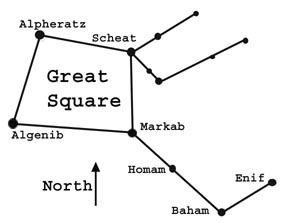
|  | |
| Graphical representation of Pegasus from Sesti's "The Glorious Constellations" | Simple diagram of Pegasus based on a similar chart from Sesti's book (by Curt Roelle) |
The seasons have trademark constellations and starry asterisms dominating their nighttime skies. Orion swings his club through the long dark nights of winter. In summer months, three stars from three constellations make up the "summer triangle". Leo the Lion and the Ursa Major the great bear -- harboring the "Big Dipper" -- soar in the spring.
On Autumn nights Pegasus the flying horse leaps up from the horizon into the eastern sky and ascends to the zenith above our rotating world. Pegasus is one of the few constellations whose appearance, to my eye at least, matches the its namesake.
One recent night I stepped out of the house, looked up, and there was Pegasus rising. The impression it gave was not that of a flying horse. The frozen star pattern of Pegasus hovering above a rich starry section of the Milky Way reminded me of an untamed horse galloping along a sandy beach with front and back legs outstretched in mid stride.
In reality the constellation of Pegasus is only the front half of a horse. The horse's rear end and legs is actually another constellation, the princess Andromeda. (Please don't tell her I called her a horse's rear end.) However, visualizing Andromeda's two strands of stars as the rear legs of a horse makes Pegasus seem to come alive with motion.
The body of the horse is marked with four stars at the corners of what has long been known as the "Great Square of Pegasus." The names of the four stars, clockwise from upper left (when the square is overhead) are Alpheratz, Scheat, Markab, and Algenib. According to 19th century writer Richard Hinckley Allen these names represent the horse's navel, shoulder, saddle, and wing, respectively.
Oddly, Pegasus flies upside down when viewed from most of earth's northern hemisphere. The reason for this has been lost. In "The Glorious Constellations: History and Mythology" Giuseppe Maria Sesti speculates the inverted attitude was the result of being bitten on the rump by a horsefly sent by Zeus to prevent Bellerophon from reaching Olympus on the back of Pegasus. The horse rolled over and poor Bellerophon tumbled off and into a bramble bush.
From southern Peru's mountain desert I have watch Pegasus flying right side up low in the northern sky. Its proximity to the horizon created an illusion of immense size. This is also known as the "full moon" effect that makes the moon seem larger the closer it is to the horizon.
To deep sky observers with moderate to large telescopes Pegasus and Andromeda are happy hunting grounds for galaxies. At a distance of more than two million light years the Great Andromeda galaxy is visible to the unaided eye from dark sites away from cities and towns.
Would you like to see the Andromeda galaxy or some of Autumn's other treats through a telescope? The Westminster Astronomical Society will have a public star party at Bear Branch Nature Center (BBNC) starting at 07:30 p.m. on Saturday, October 28. Reservations for planetarium shows that evening may be reserved by calling BBNC at 410-848-2517. The nature center collects a nominal fee for the planetarium but the telescope observing is free.

|  | |
| Graphical representation of Pegasus from Sesti's "The Glorious Constellations" | Simple diagram of Pegasus based on a similar chart from Sesti's book (by Curt Roelle) |